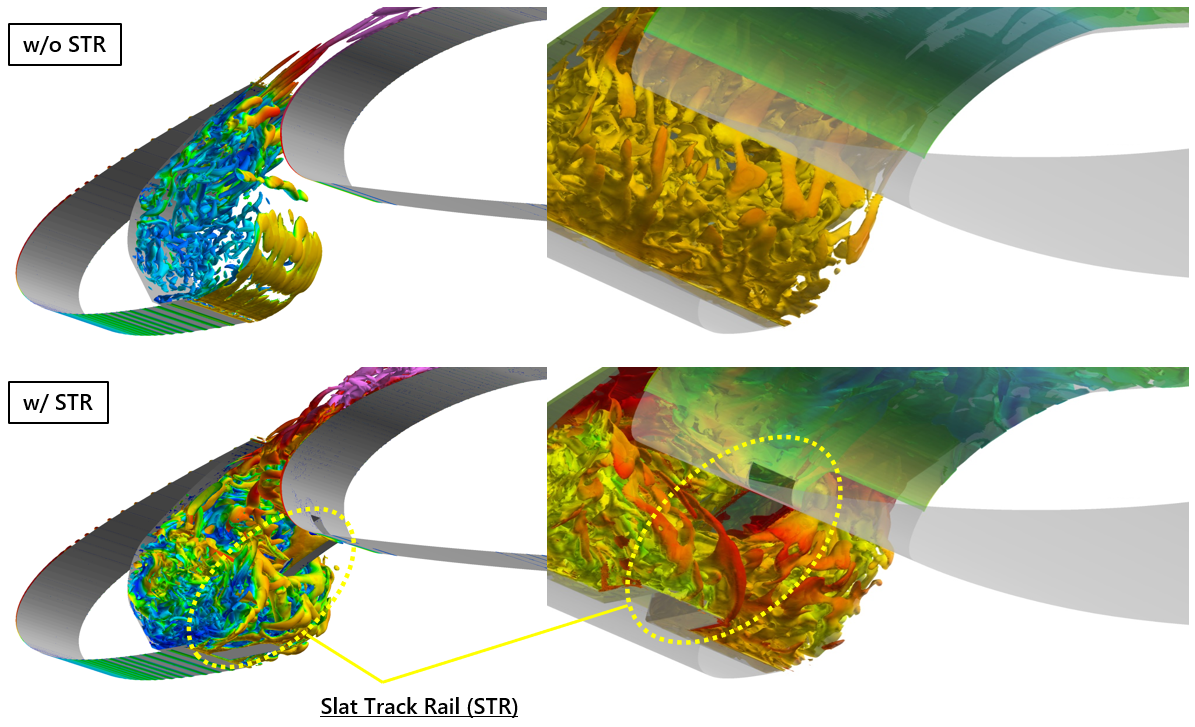Research on Airframe Noise Reduction Design (FQUROH+)
JAXA Supercomputer System Annual Report April 2020-March 2021
Report Number: R20EDA101R21
Subject Category: Aeronautical Technology
- Responsible Representative: Yoshikazu Makino, Aviation Systems Research Unit, Aeronautical Technology Directorate
- Contact Information: Takehisa Takaishi, Flight Demonstration of Quiet Technology to Reduce Noise from High-Lift Configurations (FQUROH+) Team, Aviation Systems Research Unit, Aeronautical Technology Directorate(takaishi.takehisa@jaxa.jp)
- Members: Takehisa Takaishi, Mitsuhiro Murayama, Yasushi Ito, Ryotaro Sakai, Kazuomi Yamamoto, Tohru Hirai, Kentaro Tanaka, Kazuhisa Amemiya, Gen Nakano, Takashi Ishida
Abstract
This research is being carried out as part of the FQUROH (Flight Demonstration of Quiet Technology to Reduce Noise from High-Lift Configurations) project aimed at raising the technical maturity level of the noise reduction technology for high-lift devices and landing gear, which draws international attention to reduce noise in areas around airports, to a level applicable to future development of aircraft and related equipment. This contributes to reduction of aircraft noise in local communities around the airport and airline operating costs by reducing landing fee. One of the objectives of the FQUROH project is to verify the feasibility of practical noise reduction concepts and design methods based on advanced, large-scale computational simulations based on Large/Detached Eddy Simulations (LES/DES).
Reference URL
Please refer to https://www.aero.jaxa.jp/eng/research/ecat/fquroh/ .
Reasons and benefits of using JAXA Supercomputer System
The JSS2 was used to understand detailed physics of noise generation, and to optimize noise reduction designs. The FQUROH project aims to accelerate technology maturity of airframe noise reduction methods using advanced large-scale, high-fidelity computational simulations on the JSS2's high performance computing platform and to demonstrate the high-fidelity design technologies through flight tests. Computational simulations using the JSS2 made it possible to design low-noise devices by understanding detailed physical phenomena, which was difficult to obtain only with wind tunnel tests.
Achievements of the Year
Unsteady flow simulations have been conducted to understand flow characteristics around slats including slat track rails that have been found to be major noise sources for airframe noise during landing. A representative part of a main wing was modeled with a periodic boundary condition in the spanwise direction so that highly-resolved flow field can be achieved using a dense mesh. Based on findings obtained by these simulations, noise reduction concepts for the slats have been proposed and the shape design of the noise reduction devices for a civil aircraft has been implemented.

Fig.1: Isosurfaces of Q-criterion colored by Mach number (left) and density (right) around a slat including a slat track rail from an unsteady flow simulation result for the representative part of the main wing.
Publications
N/A
Usage of JSS
Computational Information
- Process Parallelization Methods: MPI
- Thread Parallelization Methods: N/A
- Number of Processes: 1728 - 3456
- Elapsed Time per Case: 130 Hour(s)
Resources Used(JSS2)
Fraction of Usage in Total Resources*1(%): 0.81
Details
Please refer to System Configuration of JSS2 for the system configuration and major specifications of JSS2.
| System Name | Amount of Core Time(core x hours) | Fraction of Usage*2(%) |
|---|---|---|
| SORA-MA | 4,527,735.40 | 0.86 |
| SORA-PP | 85,621.17 | 0.67 |
| SORA-LM | 6,249.90 | 3.67 |
| SORA-TPP | 0.00 | 0.00 |
| File System Name | Storage Assigned(GiB) | Fraction of Usage*2(%) |
|---|---|---|
| /home | 48.66 | 0.04 |
| /data | 15,308.11 | 0.30 |
| /ltmp | 1,552.32 | 0.13 |
| Archiver Name | Storage Used(TiB) | Fraction of Usage*2(%) |
|---|---|---|
| J-SPACE | 280.06 | 9.27 |
*1: Fraction of Usage in Total Resources: Weighted average of three resource types (Computing, File System, and Archiver).
*2: Fraction of Usage:Percentage of usage relative to each resource used in one year.
Resources Used(JSS3)
Fraction of Usage in Total Resources*1(%): 0.01
Details
Please refer to System Configuration of JSS3 for the system configuration and major specifications of JSS3.
| System Name | Amount of Core Time(core x hours) | Fraction of Usage*2(%) |
|---|---|---|
| TOKI-SORA | 16.07 | 0.00 |
| TOKI-RURI | 184.68 | 0.00 |
| TOKI-TRURI | 0.00 | 0.00 |
| File System Name | Storage Assigned(GiB) | Fraction of Usage*2(%) |
|---|---|---|
| /home | 73.05 | 0.05 |
| /data | 17,238.08 | 0.29 |
| /ssd | 101.63 | 0.05 |
| Archiver Name | Storage Used(TiB) | Fraction of Usage*2(%) |
|---|---|---|
| J-SPACE | 280.06 | 9.27 |
*1: Fraction of Usage in Total Resources: Weighted average of three resource types (Computing, File System, and Archiver).
*2: Fraction of Usage:Percentage of usage relative to each resource used in one year.
JAXA Supercomputer System Annual Report April 2020-March 2021


